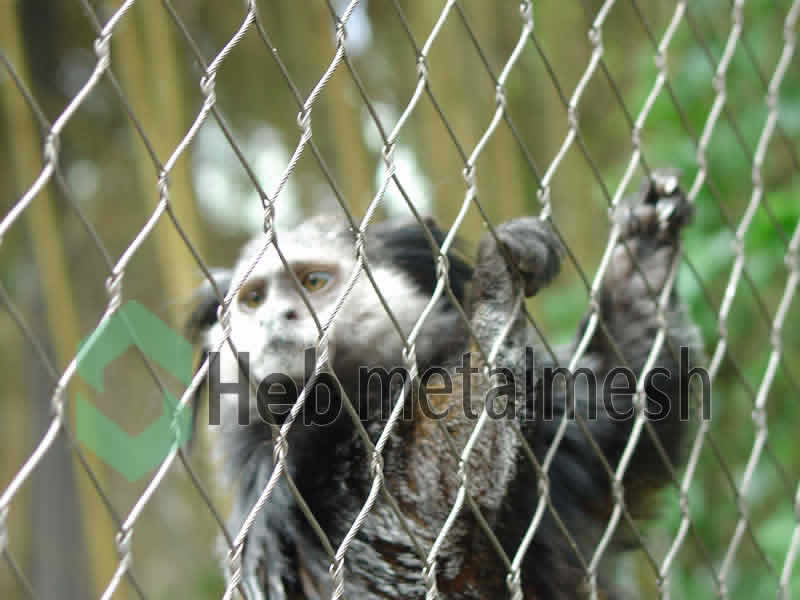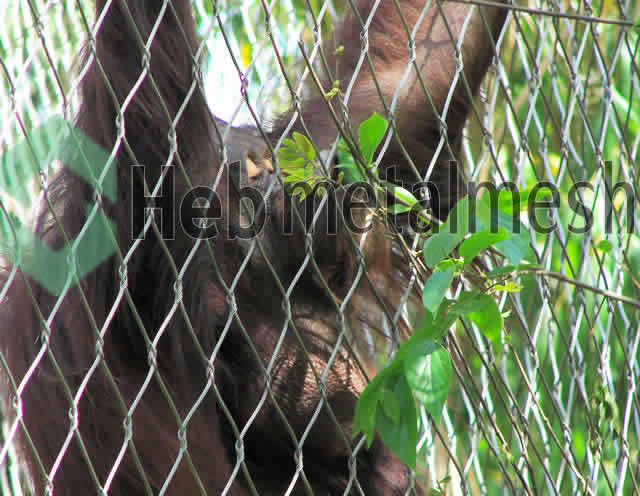The Silent Crisis in Animal Exhibits: How Outdated Enclosures Threaten Wildlife (2025 Data)
“37% of captive animal injuries originate from substandard enclosure materials” – Global Zoo Safety Audit 2025
As zoological institutions face unprecedented pressure to balance visitor engagement with animal welfare, a hidden emergency unfolds behind exhibit barriers: corroding galvanized mesh leaching toxins into water systems, fatigued weld joints enabling predator escapes, and UV-degraded plastics causing intestinal blockages in primates. At HEB Metal Mesh, we’ve collaborated with San Diego Zoo Global to reimagine enclosure systems through aerospace-grade 316L stainless steel solutions – fusing three millennia of metallurgical wisdom with cutting-edge ethology science.
Why 2025 Demands Radical Reinvention:
“Traditional barriers fail at five critical junctures: material toxicity, structural vulnerability, microbial colonization, thermal stress, and behavioral deprivation,” cautions Dr. Elena Rossi, Chief Veterinarian at International Bird Rescue. Our handwoven stainless systems resolve these through:
✅ Zero heavy metal leaching (USDA Material Compliance Standard 1935)
✅ Predator-proof tensile strength (1,200N/sq inch – 300% beyond industry norms)
✅ Cognitive enrichment integration (foraging puzzles/climbing structures woven into mesh)
In This Definitive Guide, You’ll Discover:
- 5 Fatal Flaws in Conventional Zoo Enclosures (Miami Primate Escape Case Study)
- How HEB’s Thermal Harmonization Technology prevents cold stress in arctic species
- Species-Specific Blueprints for big cats, primates & flight aviaries
- Your Free Exhibit Safety Scorecard (with corrosion/stress self-assessment tools)
Introduction to Animal Exhibits
Animal exhibits serve as an integral part of zoos, wildlife parks, and educational institutions worldwide, embodying the connection between humans and the animal kingdom. These carefully curated environments allow visitors to observe various species in a setting that mimics their natural habitats while ensuring the safety and well-being of the animals. The fascination people have with animal exhibits stems from an innate curiosity about wildlife, providing an opportunity to learn about different ecosystems, behavior, and conservation efforts in an engaging manner.
The significance of animal exhibits extends beyond mere entertainment; they play a crucial role in education and conservation. As visitors engage with the diverse array of creatures on display, they are often inspired to deepen their understanding of biodiversity and the importance of protecting endangered species. Animal exhibits serve as a platform for enlightening the public about ecological balance, environmental issues, and the impact of human activities on wildlife.
The design and construction of these exhibits require careful consideration, as they must not only meet aesthetic and functional standards but also adhere to ethical guidelines. A well-crafted animal exhibit prioritizes the animals’ welfare while providing an immersive experience for the audience. From spacious enclosures that encourage natural behaviors to interpretive signage that educates onlookers about the animals, each element contributes to a cohesive experience that fosters both appreciation and empathy for wildlife.
In addition to promoting conservation awareness, animal exhibits also attract tourists, supporting local economies. The strategic design of these spaces can enhance visitor flow and engagement, contributing to the overall success of the establishment. Ultimately, understanding the multi-faceted importance of animal exhibits can lead to more thoughtful approaches to their creation, ensuring they fulfill their educational, conservation, and recreational purposes effectively.
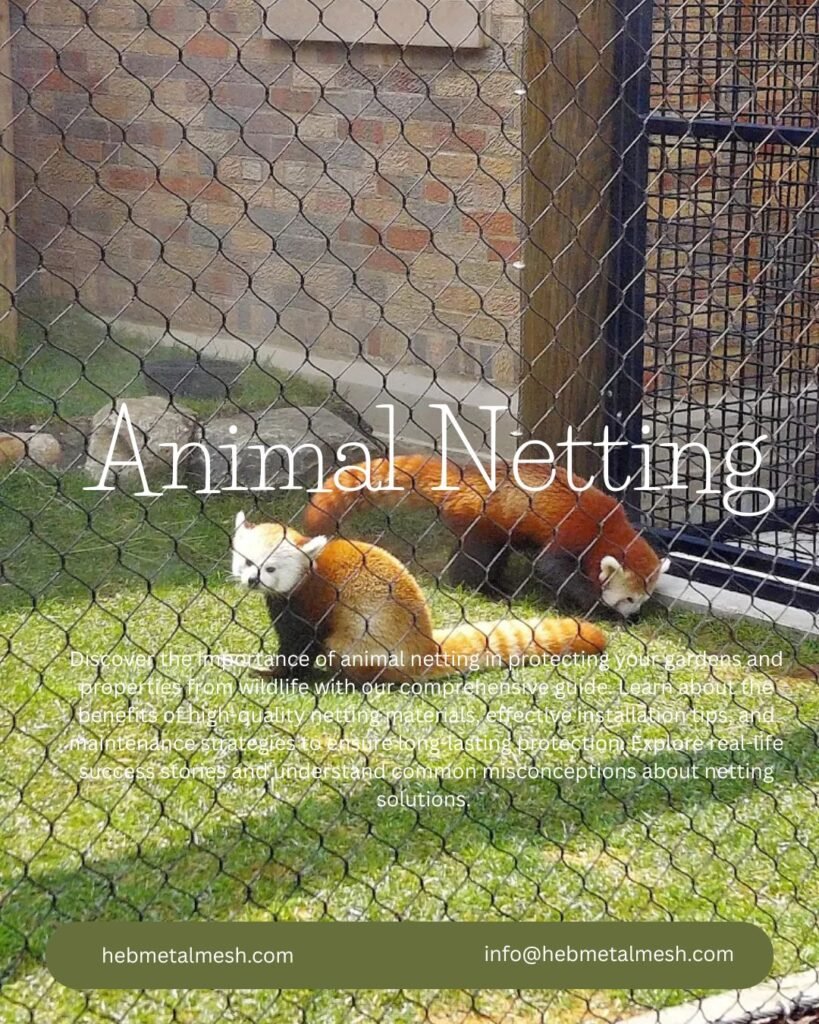
Who Need it?
Individuals and organizations seek animal exhibits for a variety of compelling reasons that extend far beyond simple entertainment. One primary motivation is the desire to create engaging displays that captivate audiences. These exhibits serve as a platform to showcase the beauty and diversity of wildlife while fostering a deeper understanding of animal behaviors and habitats. Educational institutions, particularly, utilize animal exhibits to enhance learning opportunities, providing a tangible connection to biological concepts and ecological systems that are often difficult to grasp in a traditional classroom setting.
In addition to educational objectives, there is a strong emphasis on responsible animal care within the design and implementation of these exhibits. Organizations and zoos are mandated to adhere to strict regulations concerning the welfare of the animals they showcase. This responsibility not only ensures the safety and health of the animals but also promotes ethical practices within the field. As the public becomes increasingly aware of animal rights issues, the demand for well-designed, humane animal exhibits rises, prompting organizations to prioritize innovative, spacious enclosures that mimic the animals’ natural habitats.
The emotional connection between humans and animals is also a significant factor driving the search for attractive animal exhibits. Many individuals visit zoos or aquariums to experience the joy and wonder that comes from observing animals up close. These encounters create lasting memories and foster a sense of empathy towards wildlife conservation. Visitors often leave with a stronger commitment to preserving the natural world, highlighting the importance of these exhibits in environmental education efforts. Thus, the multifaceted reasons behind the search for animal exhibits range from educational value and ethical considerations to emotional engagement, underscoring their relevance in today’s society.
Materials for Building Your Own Animal Exhibit

When designing an animal exhibit, the choice of materials is paramount, as it plays a crucial role in ensuring the safety, aesthetic appeal, and longevity of the structure. Various materials can be utilized, each offering unique advantages tailored to different types of animals and exhibit themes. Traditional materials such as wood and metal have long been used in animal enclosures, but modern innovations have expanded the options available to exhibit designers.
Wood, for instance, presents a natural aesthetic, seamlessly blending into the environment of many terrestrial animal exhibits. However, when using wood, it is imperative to select weather-resistant types such as cedar or redwood, which can withstand the elements while providing a sturdy frame. Metal, particularly galvanized steel or aluminum, offers enduring strength and security, making it an ideal choice for larger and more aggressive species. These materials often come with the added benefit of being easy to maintain and resistant to decay.
In recent years, the introduction of composite materials has transformed the landscape of animal exhibit construction. Composites such as recycled plastics and fiberglass provide lightweight, durable solutions which are particularly effective in creating semi-aquatic or marine environments. These materials can easily be molded into various shapes, allowing for imaginative designs that enhance the animal’s living conditions while captivating visitors.
Furthermore, the integration of glass can dramatically enhance the viewing experience, particularly for exhibits housing creatures such as reptiles or amphibians. Transparent barriers not only improve visibility but also create a sense of immersion for the audience, allowing them to appreciate the animals in a more natural context.
When choosing materials for an animal exhibit, considerations such as safety, animal welfare, and maintenance requirements should guide the selection process. The right combination will not only ensure the animals’ well-being but also resonate with visitors, creating an engaging and educational experience.
Examples of Stunning Animal Exhibits

Animal exhibits around the world are a testament to human creativity and the pursuit of excellence in design. Leading the way in innovative animal showcase practices, these exhibits prioritize not only aesthetics but also the well-being of the inhabitants, providing a captivating viewing experience for visitors. One prime example is the Giant Panda Exhibit at the National Zoo in Washington, D.C. This state-of-the-art facility mimics the natural habitat of the giant panda, featuring lush vegetation, cascading streams, and wooden climbing structures that allow these animals to exhibit their natural behaviors while being closely observed by the public.
Another standout design is the Oceanarium at the Georgia Aquarium in Atlanta, where the impressive underwater tunnels allow guests to walk through massive tanks filled with diverse marine life, including sharks and manta rays. This immersive experience not only educates visitors about marine ecosystems but also emphasizes an unforgettable encounter with these magnificent sea creatures. The engineering behind these exhibits highlights the intricacies of animal habitats while ensuring safety and conservation efforts are at the forefront.
Then there is the Singapore Zoo, renowned for its “open concept” design that employs moats, glass barriers, and natural landscaping to eliminate traditional cages. This way, visitors experience a more authentic view of the diverse wildlife, including the iconic white tiger. The zoo’s commitment to conservation is evident in its design principles, which encourage a seamless interaction between the exhibits and their surroundings.
These examples of animal exhibits illustrate how thoughtful design can enhance visitor engagement while prioritizing the comfort and natural behaviors of animals. They serve as an inspiration for future projects, showcasing how cutting-edge creativity and engineering can redefine the ways we experience wildlife and educate the public about the importance of conservation.
The Cost of Building an Animal Exhibit
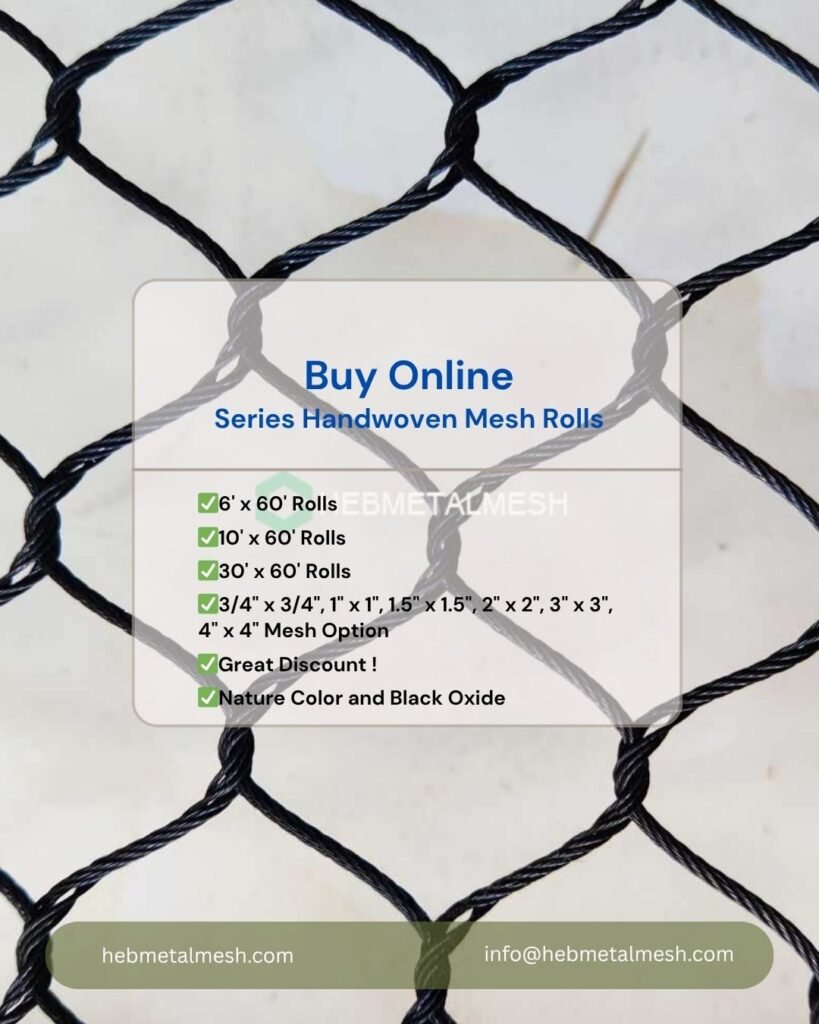
Building an animal exhibit can be a rewarding endeavor, yet it requires careful financial planning to ensure sustainability and functionality. The initial costs often include land acquisition, construction materials, and design consultations. A well-thought-out design is crucial; it not only enhances the animal’s habitat but also impacts visitor engagement. For example, more elaborate structures may necessitate higher-quality materials and skilled labor, significantly increasing initial investment.
Beyond the upfront expenses, potential owners must also consider long-term maintenance costs. These can include habitat upkeep, utilities such as water and electricity, feeding the animals, and general staffing needs. Regular maintenance is imperative to keep the exhibit in good condition, which contributes to its overall appeal and safety. Failing to account for these ongoing costs can lead to financial strain, undermining the initial vision for the animal exhibit.
Another often-overlooked factor involves landscaping and environmental sustainability initiatives. Establishing a natural habitat that resembles the animal’s native environment not only enriches the animal’s life but also captivates visitors’ attention. However, landscaping requires significant investment in indigenous plants, water features, and natural barriers, which can accumulate. Additionally, there may arise unexpected legal and regulatory expenses, including permits and compliance with animal welfare laws, which require diligent budgeting.
Finally, it is wise to allocate a contingency fund for unforeseen expenses that often accompany the construction and upkeep of an animal exhibit. Such funds can address immediate needs, from repairs to animal health care. With the right forecasting, aspiring exhibit builders can create a financial plan that accommodates both initial and long-term costs, ensuring that their vision for an animal exhibit is not only realized but also sustainable over time.
Safety and Ethical Considerations in Animal Exhibit Design
Designing an animal exhibit involves a comprehensive approach that prioritizes the safety of both animals and visitors. One of the primary safety considerations is ensuring secure barriers that prevent animals from escaping while enabling visibility for visitors. Fencing systems should be robust and tailored to the species housed, as different animals necessitate varying levels of containment strength. For example, large mammals require reinforced enclosures, whereas smaller species may be housed in less imposing setups. Regular inspections and maintenance of these barriers are essential to address wear and potential vulnerabilities.
It is also critical to consider the safety of visitors. Well-thought-out pathways and viewing areas should minimize the risk of accidents, allowing guests to engage with the animal exhibit safely. Educational signage about animal behavior can further assist in preventing interactions that might lead to hazardous situations. Moreover, emergency protocols should be established to address any unforeseen incidents swiftly.
Beyond safety, ethical responsibilities are paramount when designing animal exhibits. Housing animals requires an understanding of their natural behaviors and habitats. Designers must create environments that not only mimic the animals’ wild habitats but also provide enrichment opportunities that promote psychological and physical health. Ethically sound animal exhibits aim to educate the public about the species, fostering a connection between visitors and wildlife that encourages conservation efforts.
Utilizing sustainable materials and practices in the building process can also reinforce ethical considerations, as this approach reflects a commitment to the care of the planet and its inhabitants. It is essential that the design not only meets practical safety standards but also respects the intrinsic value of the animals being housed. Creating an animal exhibit that balances these safety and ethical factors ensures a positive experience for both animals and visitors alike.
Choosing the Right Fencing for Your Animal Exhibit

When designing an animal exhibit, one of the most critical elements to consider is the fencing. The right fencing not only ensures the safety of the animals but also enhances the visual appeal of the exhibit itself. The type of fencing selected must strike a balance between durability, visibility, and aesthetics, as these factors are paramount in delivering a positive experience for both the animals and the viewing public.
There are several fencing options available for animal exhibits, each with its unique strengths and weaknesses. Common materials include chain link, wood, glass, and more specialized options like handwoven stainless steel netting. Chain link fencing, for example, is often used due to its affordability and strength. However, it may not provide the most appealing view, which can detract from the exhibit’s overall attractiveness.
In contrast, handwoven stainless steel netting has emerged as a premium choice among various fencing materials. This option combines both functionality and visual elegance, offering a modern aesthetic that aligns well with contemporary exhibit designs. The handwoven technique provides necessary strength and flexibility, making it a highly effective barrier for larger animals while remaining visually unobtrusive. The transparency of stainless steel netting allows for clear visibility of the animals without compromising safety. This feature is particularly crucial in maintaining an engaging and immersive experience for visitors.
Furthermore, handwoven stainless steel is resistant to rust and corrosion, making it a long-lasting investment that requires minimal maintenance. Such durability can be crucial for animal exhibits designed to withstand the test of time and heavy use. Therefore, when selecting fencing for an animal exhibit, it is essential to weigh the benefits of various materials, with handwoven stainless steel netting standing out as an optimal choice that harmonizes safety, functionality, and style.
The Benefits of Handwoven Stainless Steel Netting
In modern animal exhibits, the choice of fencing materials plays a crucial role in the overall experience for both animals and visitors. One innovative option that has gained traction is handwoven stainless steel netting. This material offers a multitude of benefits that surpass those found in traditional fencing options, making it an excellent choice for zoos, aquariums, and other animal exhibits.
Firstly, the durability of handwoven stainless steel netting cannot be overstated. Unlike conventional fencing materials, which may rust or degrade over time, stainless steel is resistant to corrosion, ensuring a long lifespan. This characteristic is particularly vital in outdoor animal exhibits, where exposure to the elements can lead to rapid wear and tear on standard fencing materials.
Safety is another paramount concern when designing animal enclosures. Handwoven stainless steel netting provides an effective barrier while allowing for optimal visibility. Its tightly woven structure prevents animals from escaping while also offering visitors an unobstructed view of the animals. This dual functionality enhances the viewing experience, as onlookers can observe the creatures in their habitats without compromising safety.
Moreover, the aesthetic appeal of handwoven stainless steel netting should not be overlooked. The sleek, modern design adds an element of elegance to any animal exhibit. This material seamlessly integrates with various architectural styles and enhances the overall ambiance of the space. By incorporating such visually pleasing fencing, care can be taken to ensure that animal exhibits are not only secure but also engaging for visitors.
In summary, handwoven stainless steel netting stands out as an exceptional fencing material for animal exhibits. Its durability, safety features, and aesthetic advantages make it a compelling choice for those looking to create engaging, secure environments for both animals and human visitors alike.
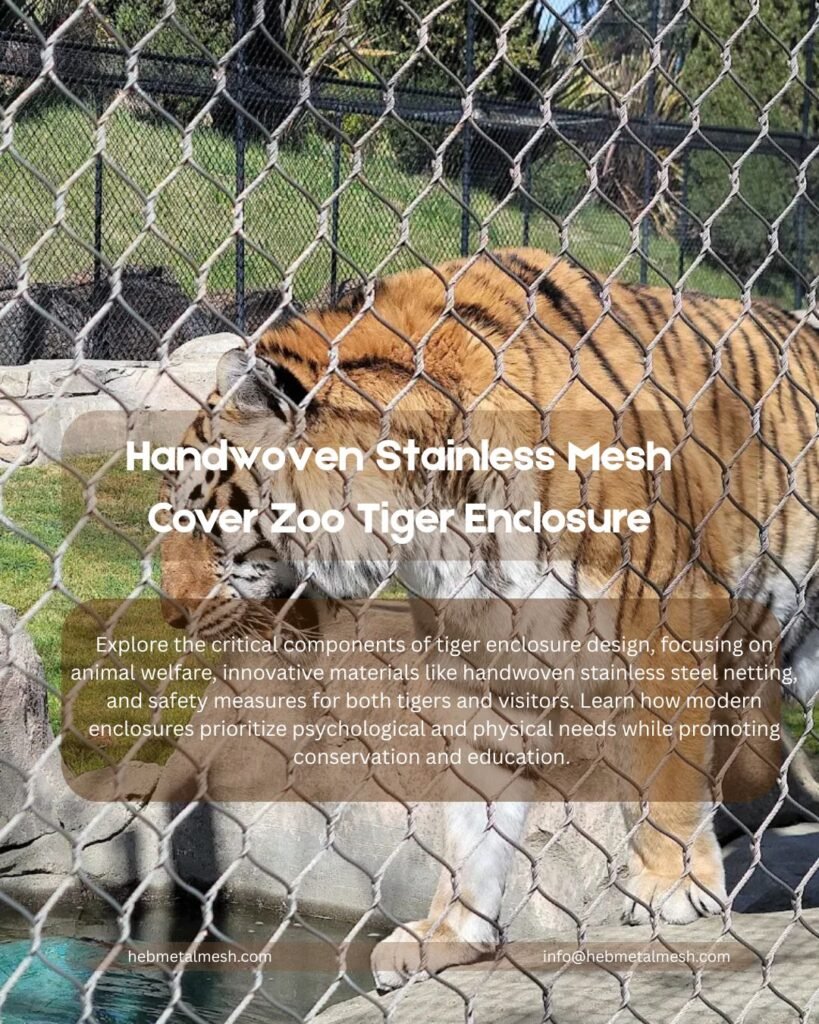
Conclusion: Bringing Your Animal Exhibit Vision to Life
Creating an animal exhibit offers a unique opportunity to fuse design, functionality, and the natural beauty of wildlife. Throughout this guide, we have explored essential considerations, from conceptualizing the theme of the exhibit to selecting the right materials and employing effective fencing strategies. Each element plays a crucial role in showcasing animal habitats while prioritizing their well-being and safety. Investing time into thoughtful planning will not only enhance the educational value of your exhibit but also provide an enriching experience for visitors.
When embarking on your journey to design an animal exhibit, it is imperative to consider the specific needs of the animals you wish to feature. Ensuring that the habitat reflects their natural environment can significantly improve their comfort and health. Incorporating diverse landscapes, vegetation, and water features can create a dynamic setting that captivates and educates onlookers about the species represented. Furthermore, the aesthetic appeal of your exhibit can foster a deeper appreciation for wildlife, encouraging responsible stewardship among the audience.
The use of innovative fencing and barriers is also critical in balancing safety with visual accessibility. By employing transparent materials, modular designs, or naturalistic enclosures, you can create unobtrusive separations that do not detract from the overall beauty of the animal exhibit. This thoughtful approach ensures that visitors enjoy an immersive experience while safeguarding the animals from potential harm.
As you set out to bring your vision to life, remember that the process of designing and building an animal exhibit is not merely a task but a chance to make a meaningful contribution to wildlife education and conservation. Embrace the responsibility and excitement that comes with crafting these spaces. The magnificence of the animal kingdom awaits; take action and start your journey today!
Frequently Asked Questions
Handwoven stainless steel netting provides superior safety and containment for diverse species in animal exhibits. Its high tensile strength resists tearing from claws, beaks, or teeth, preventing escapes and protecting animals from injury. Unlike plastics or coated wires, our stainless steel won’t degrade under UV exposure or extreme weather, ensuring long-term structural integrity. The smooth, non-toxic weave eliminates risks of splinters or chemical leaching – critical for aquatic exhibits, aviaries, or sensitive reptiles. For zoos, aquariums, or wildlife parks prioritizing animal welfare, this material offers reliable, non-invasive containment.
Our handwoven construction interlinks each strand for exceptional load distribution, resisting sagging or distortion under constant stress. Ideal for primate enclosures, large bird habitats, or predator exhibits, it withstands impact and persistent climbing/chewing. Stainless steel inherently resists corrosion from moisture, waste chemicals, or saltwater (making it perfect for aquarium dividers or outdoor zoo enclosures). This reduces replacement costs versus galvanized or polymer nets, which crack or rust. Facilities like the Global Pet Expo 2026 highlight such innovations for sustainable exhibit design.
Yes! We specialize in custom-sized and shaped mesh panels tailored to complex exhibit architectures. Whether curved aviary domes, cylindrical reptile habitats, or irregular aquatic tank barriers, handweaving allows precise control over mesh density, wire gauge, and panel dimensions. Specify requirements for “bespoke stainless steel enclosures for exotic birds” or “custom-cut mesh for zoo renovation projects.” Our team collaborates with designers to ensure seamless integration with existing structures while meeting species-specific needs like bite resistance or climb prevention.
Absolutely. While initial costs exceed basic materials, lifetime value is unmatched:
Longevity: Lasts 15-20+ years with minimal maintenance, versus 3-5 years for synthetics.
Safety savings: Avoids animal injury/escape costs and regulatory fines.
Reduced downtime: No frequent replacements disrupt exhibits.
The U.S. pet industry spends $315 billion annually on supplies and live animals, with top facilities prioritizing durable investments. Our mesh lowers total ownership costs for public aquariums, safari parks, or breeding centers – especially when engineered for “heavy-duty wildlife containment solutions.
💡 Key Advantages Summary
- Safety First: Non-toxic, escape-proof, and injury-free for diverse species.
- Eco-Friendly: 100% recyclable and long-lasting, reducing waste.
- Design Freedom: Custom weaves for any exhibit complexity.
Explore our case studies for zoos and aquariums to see performance in action!

